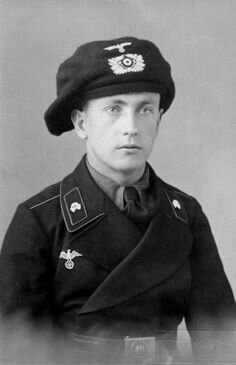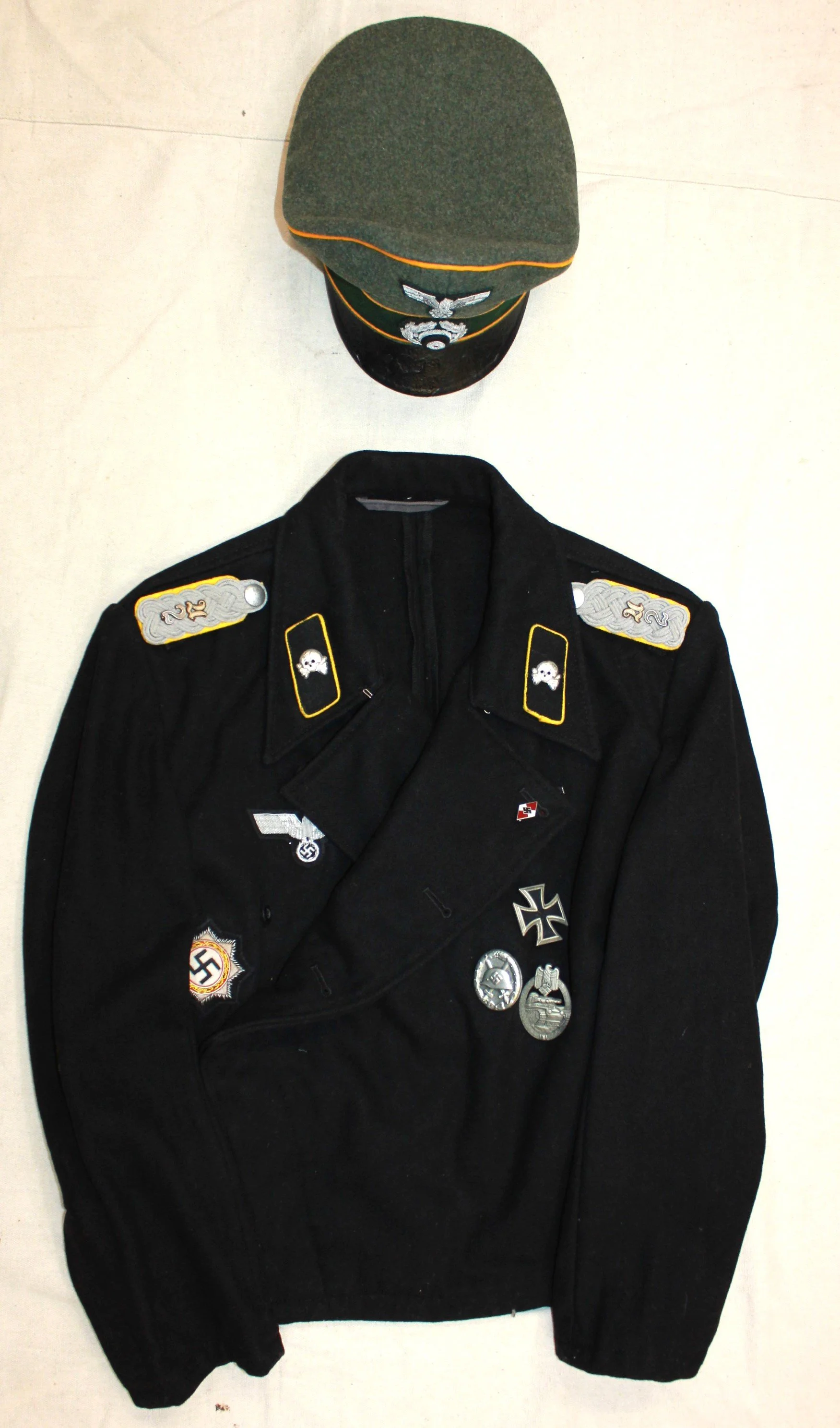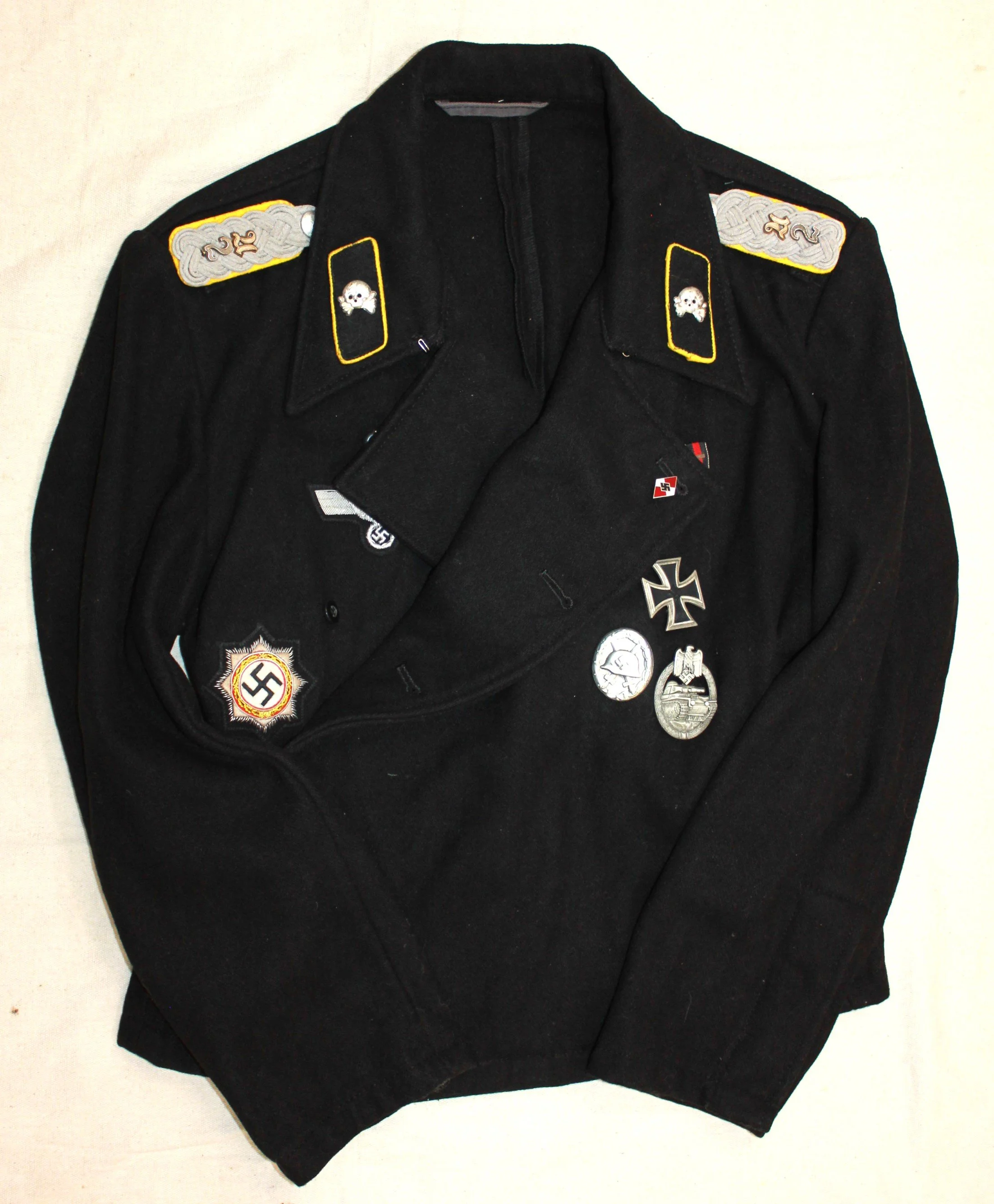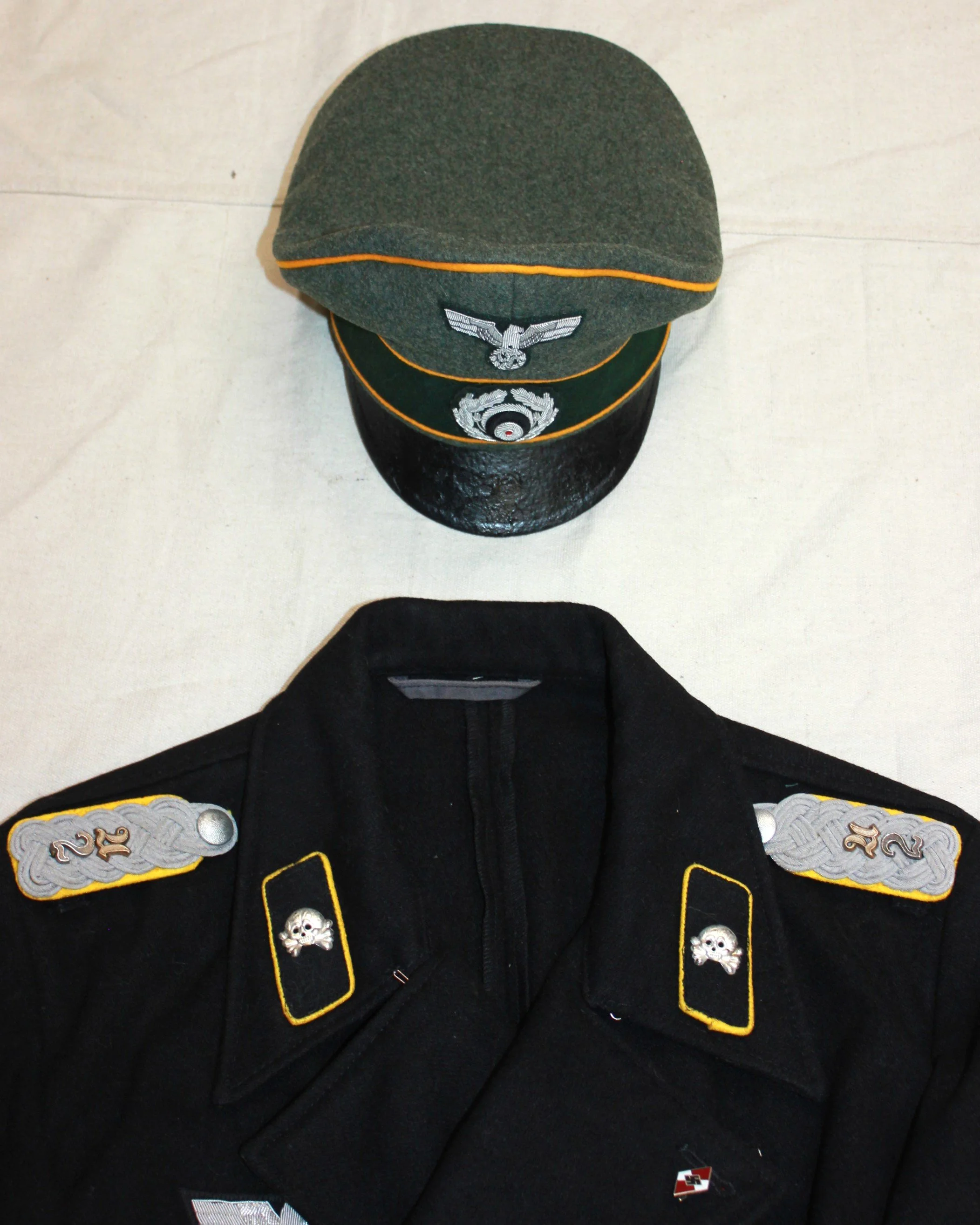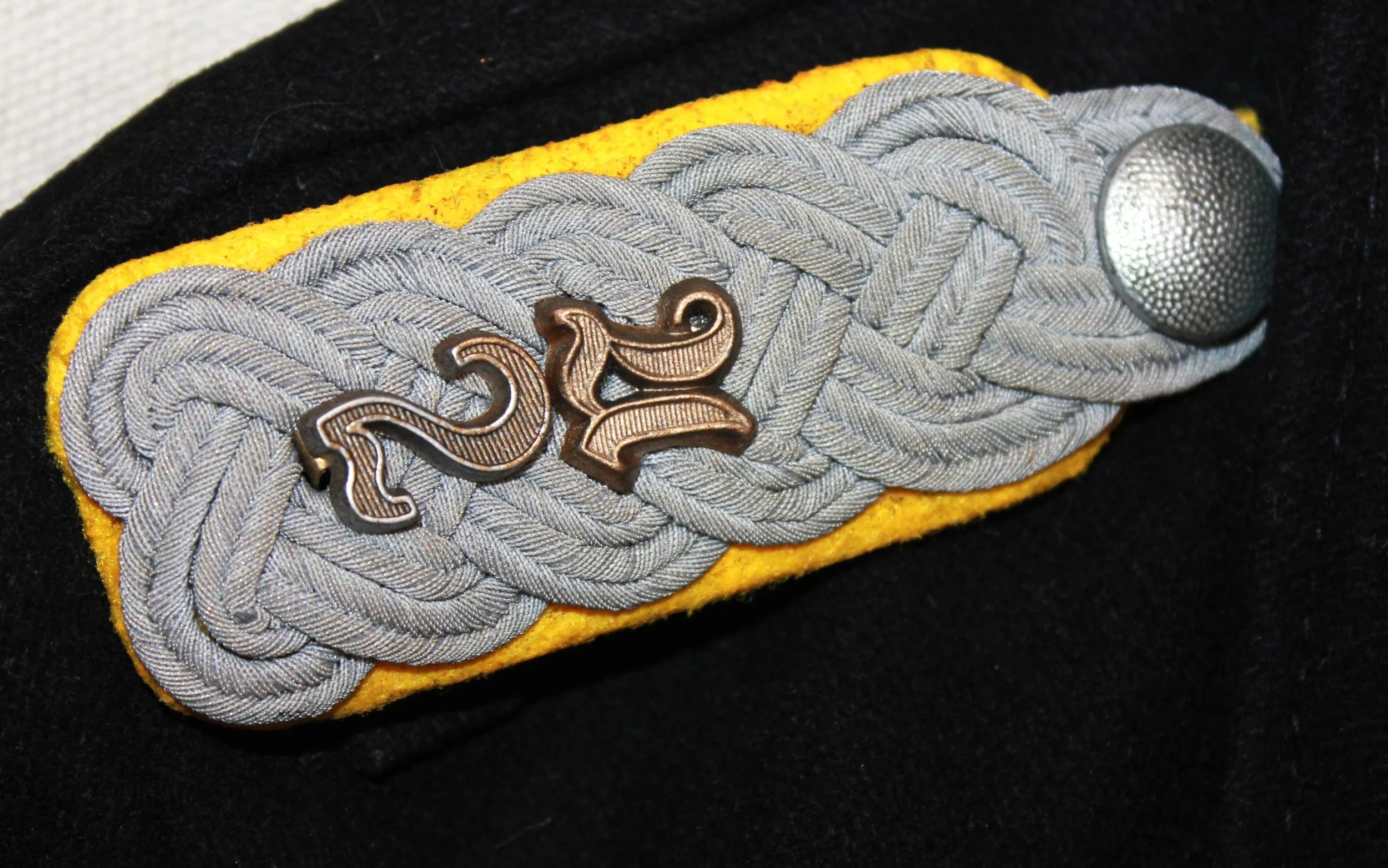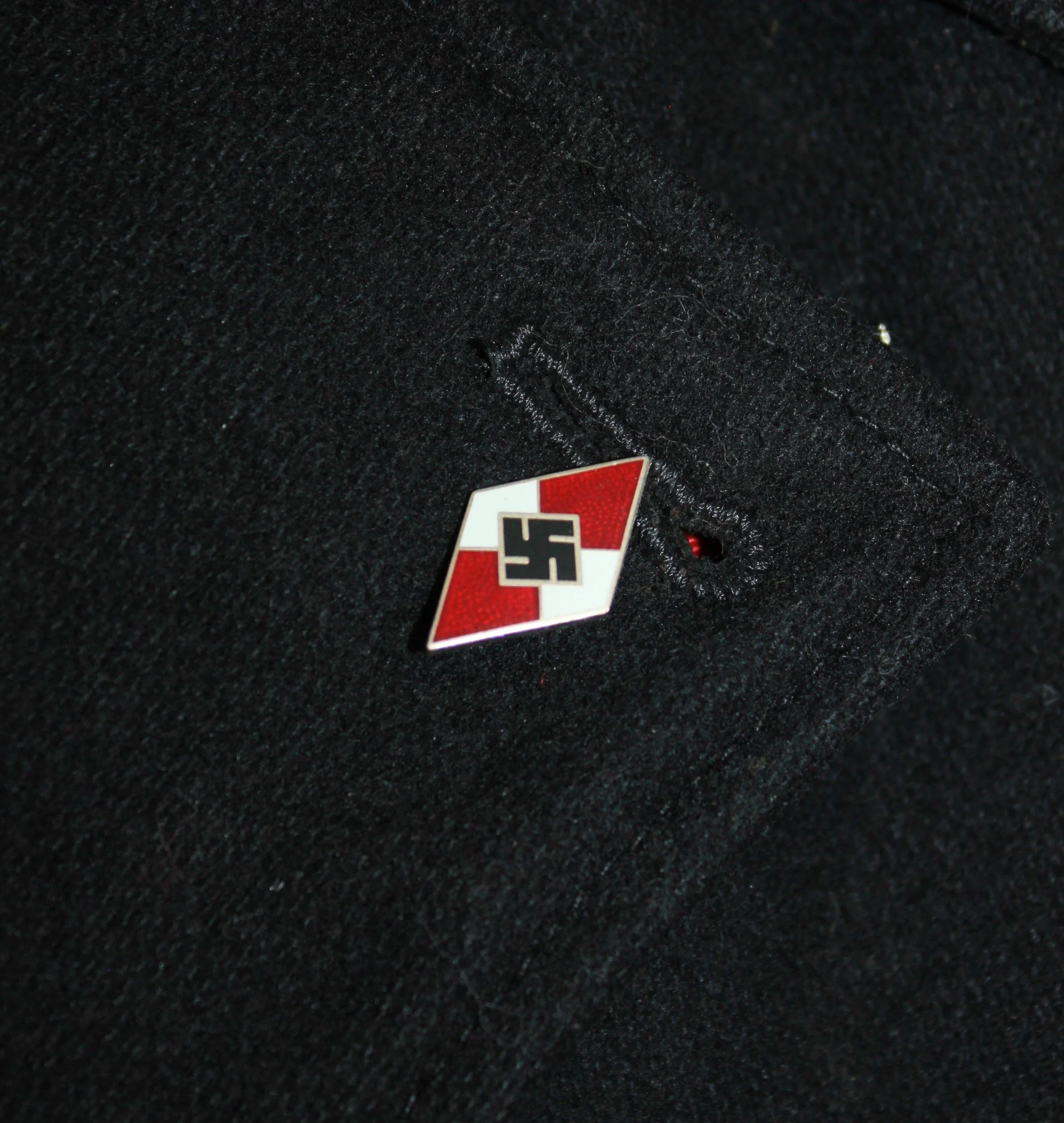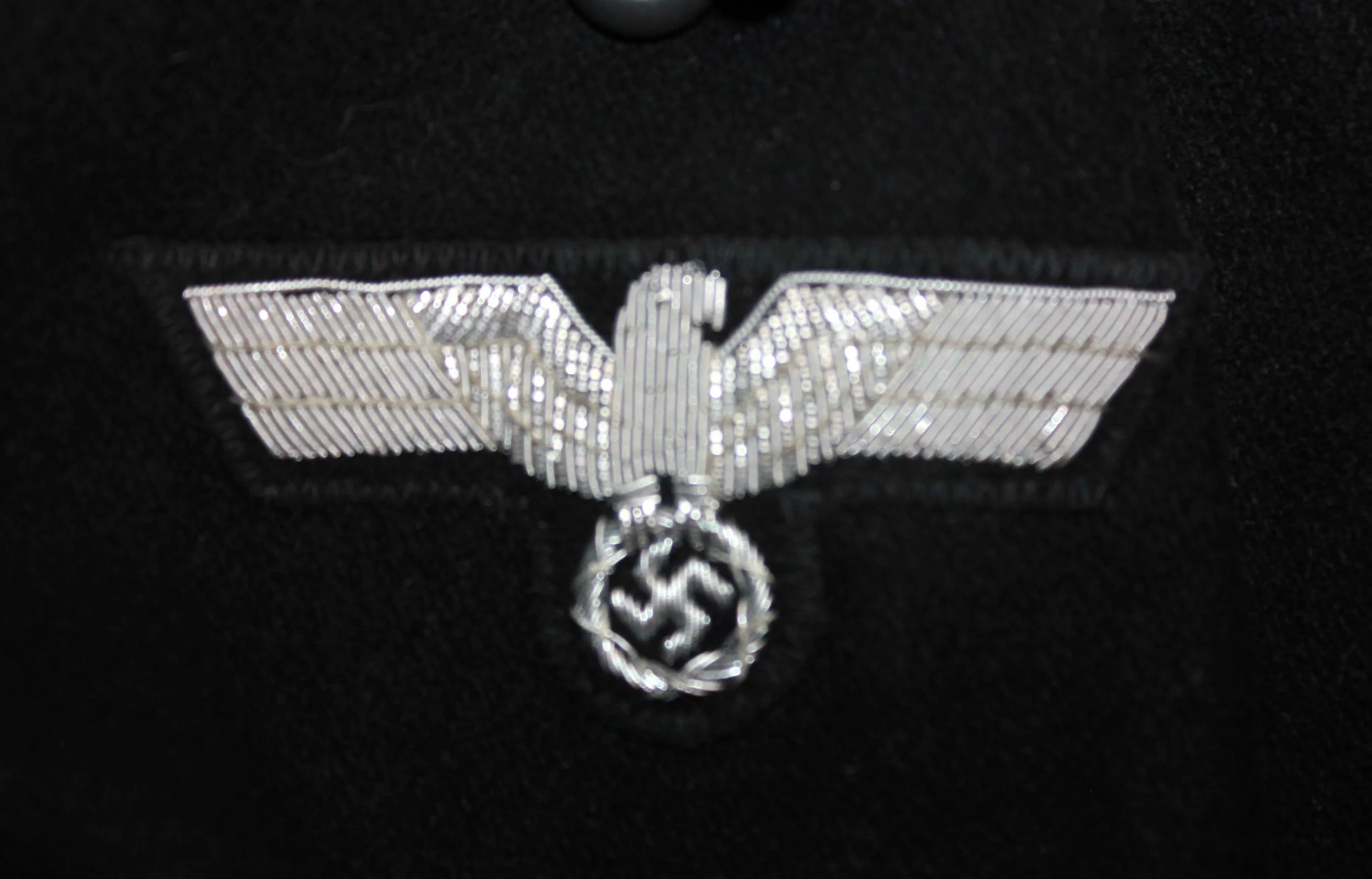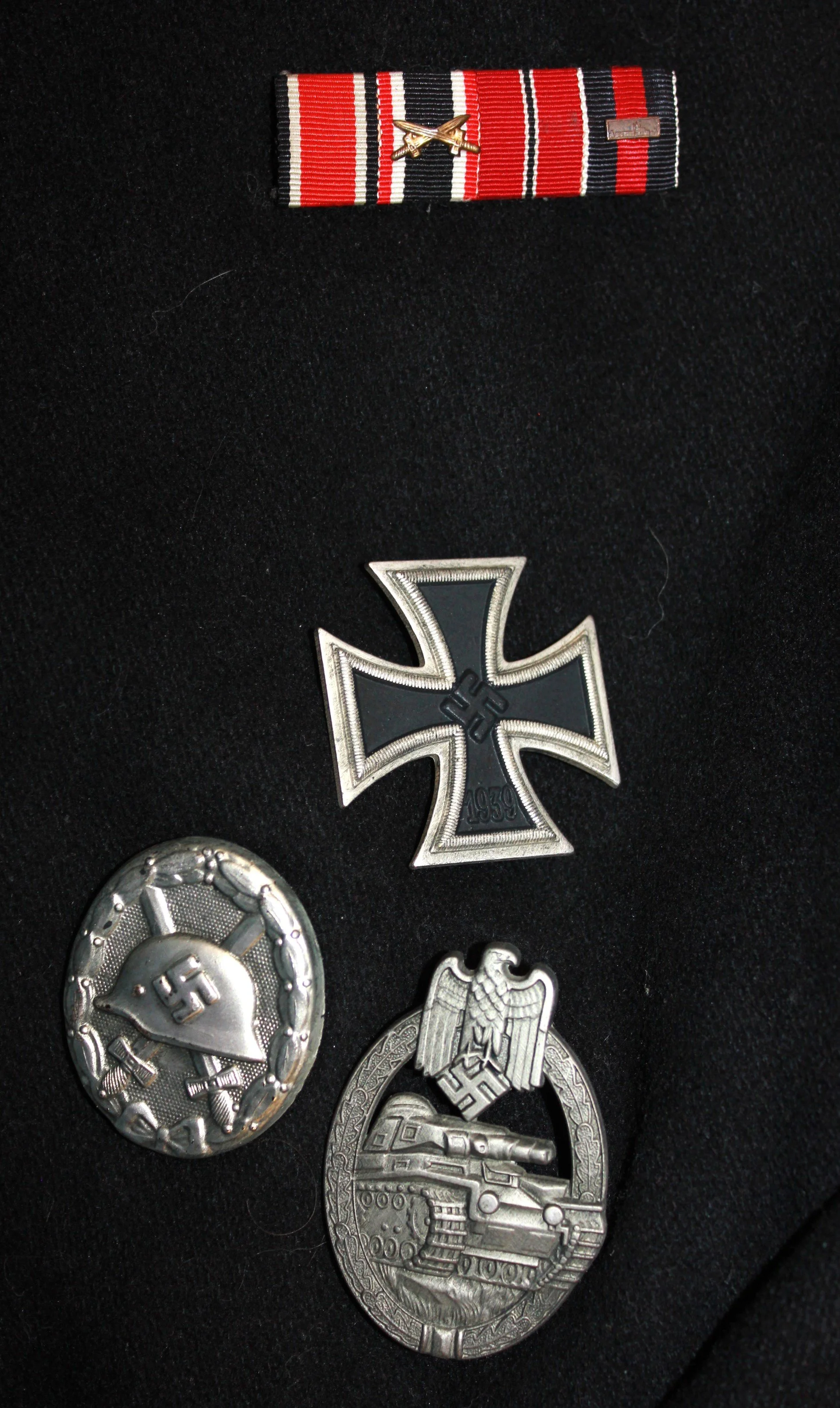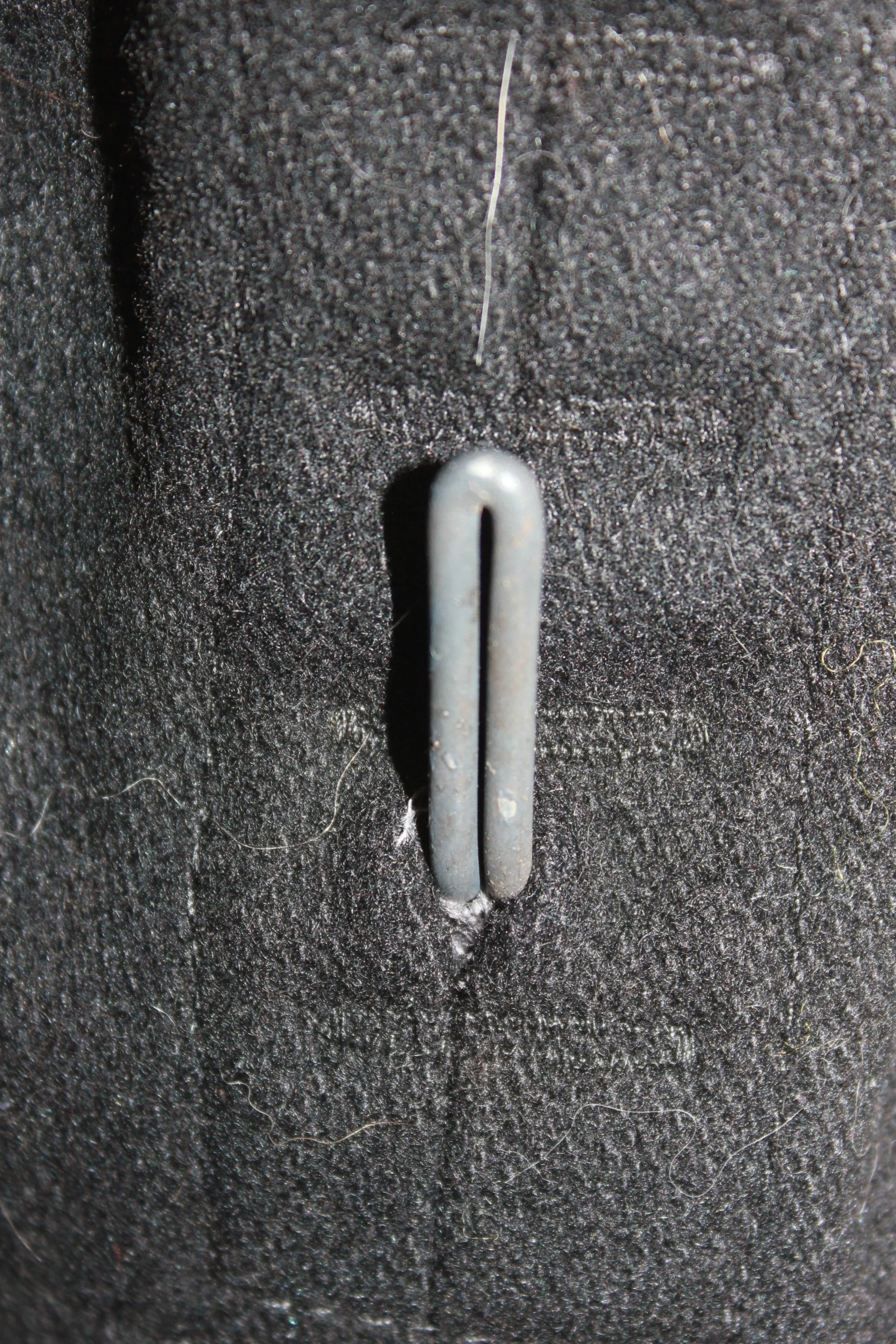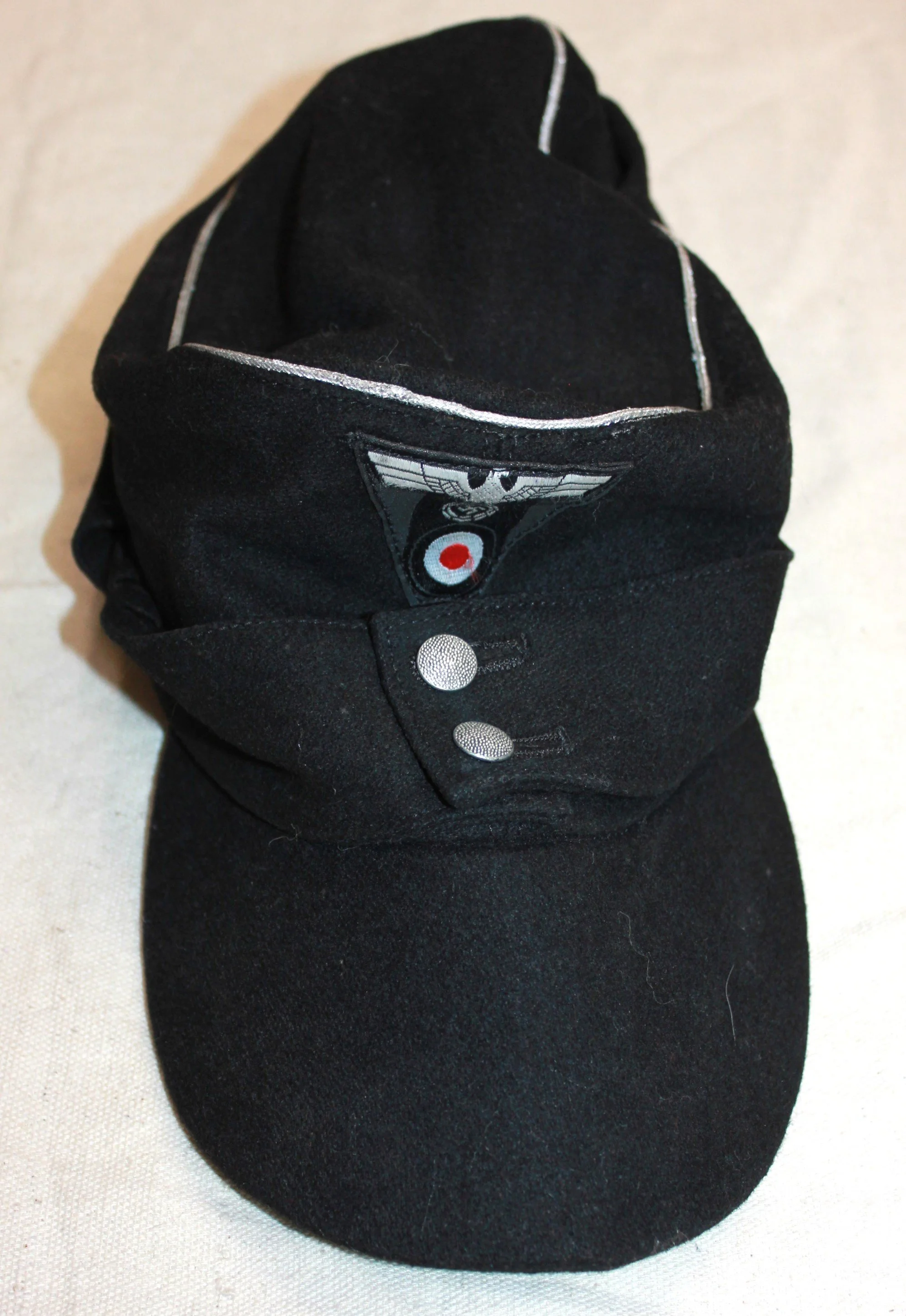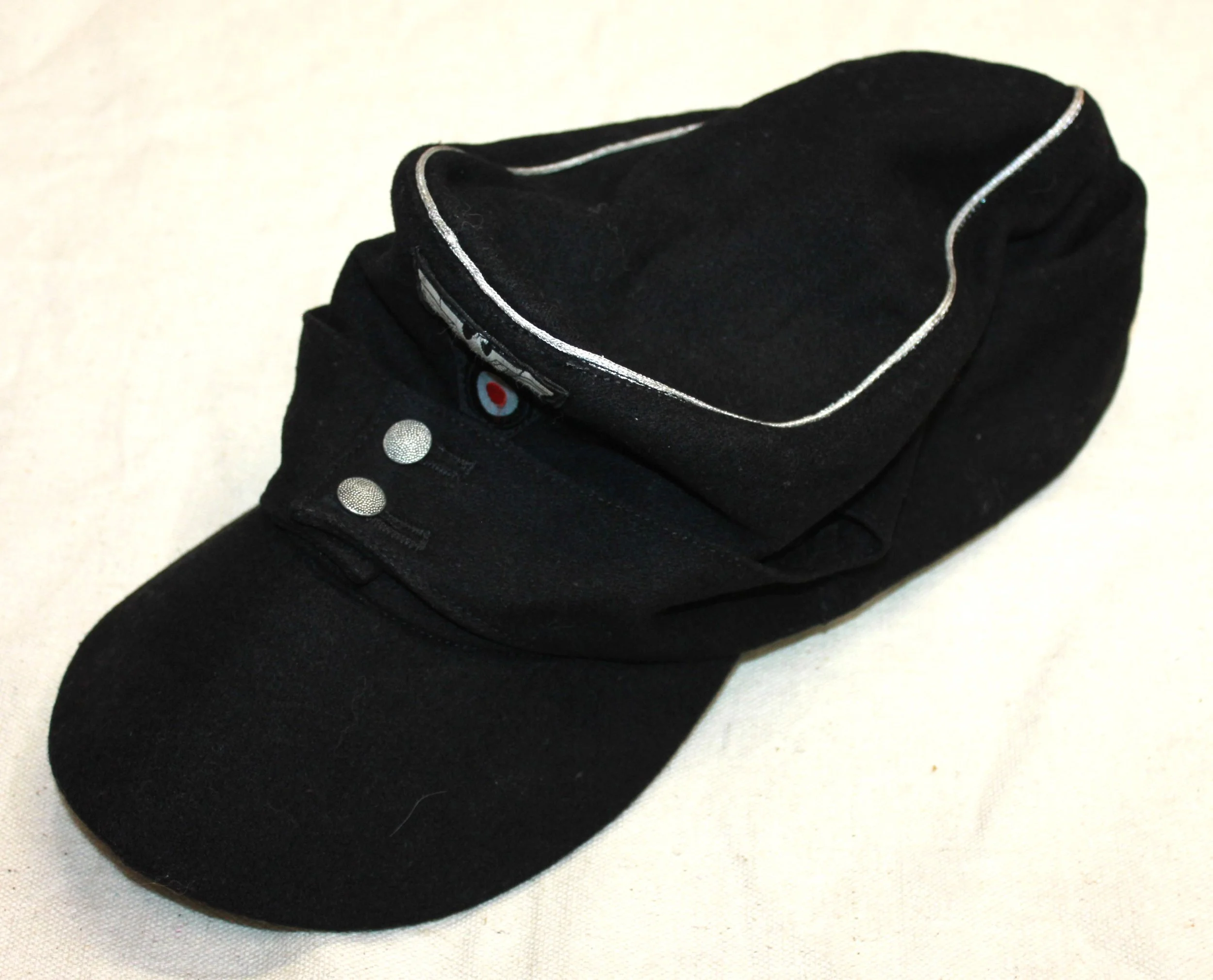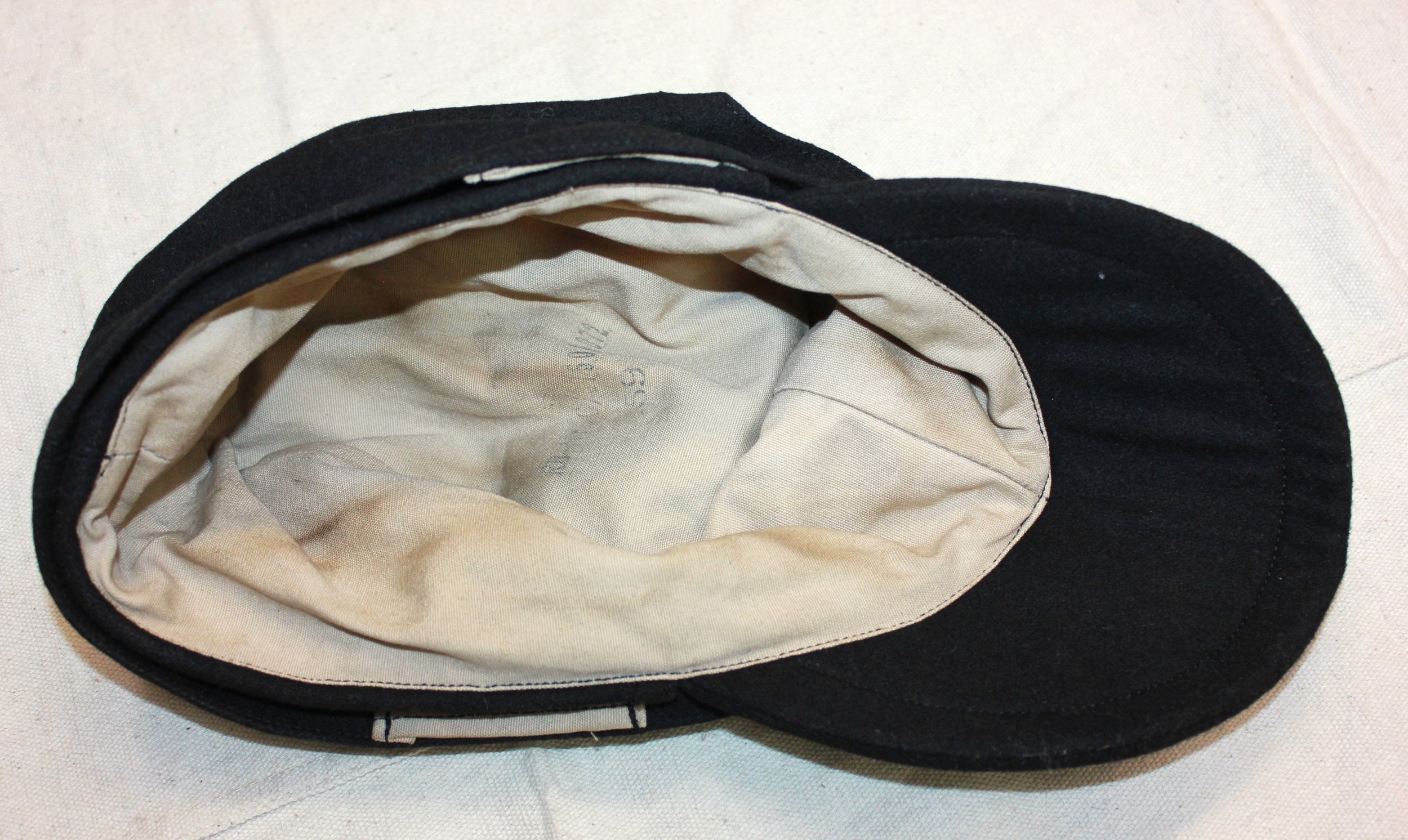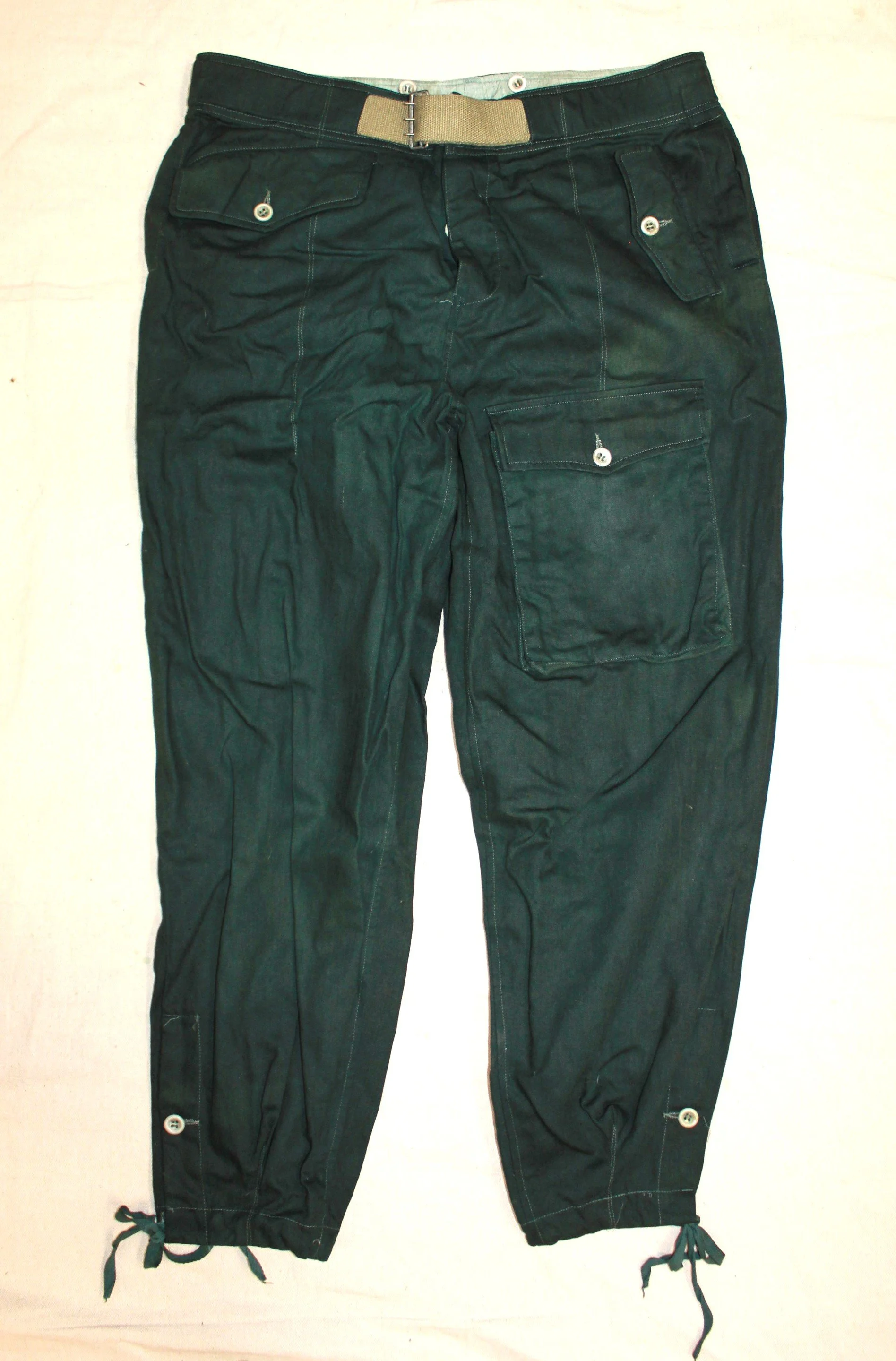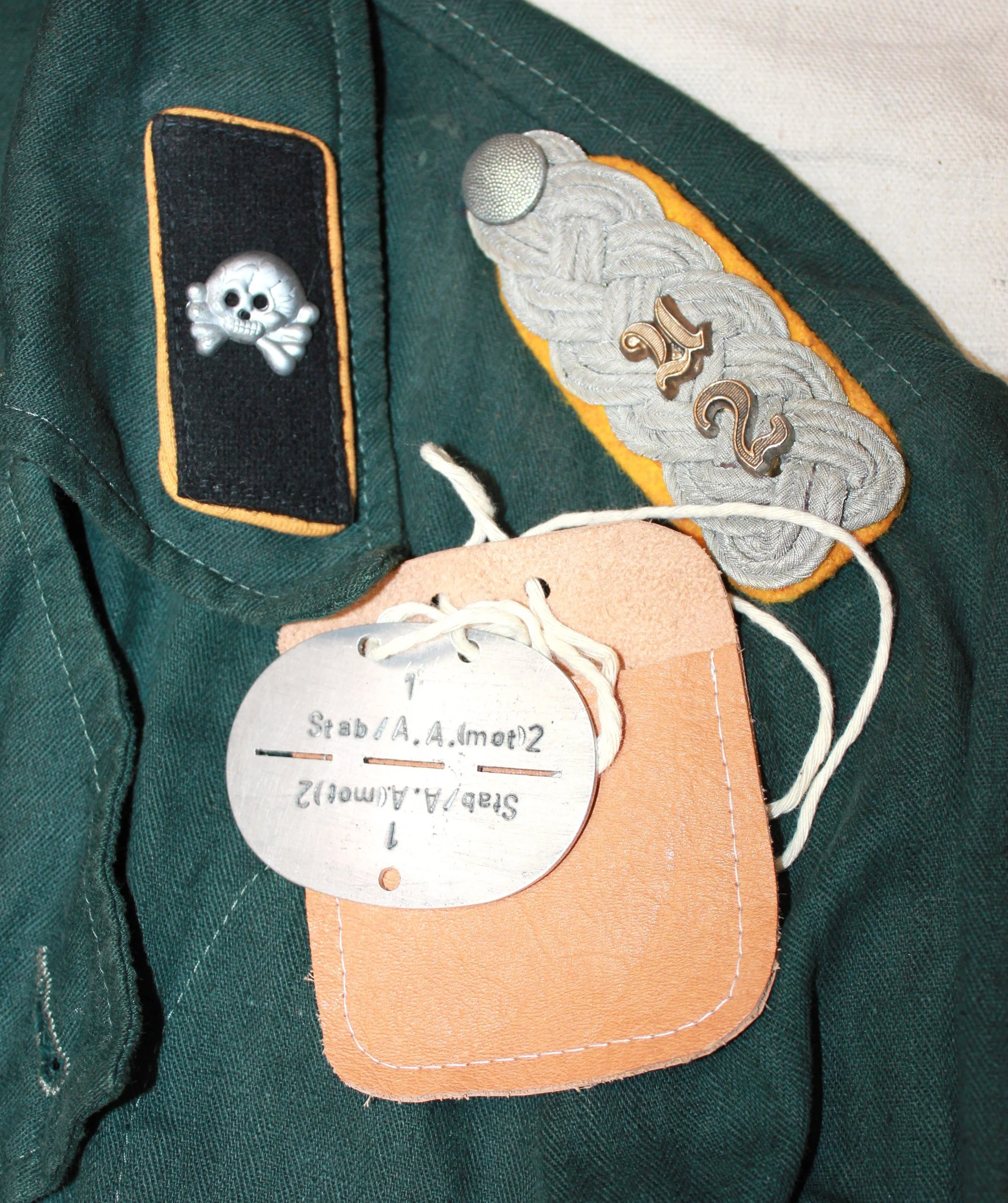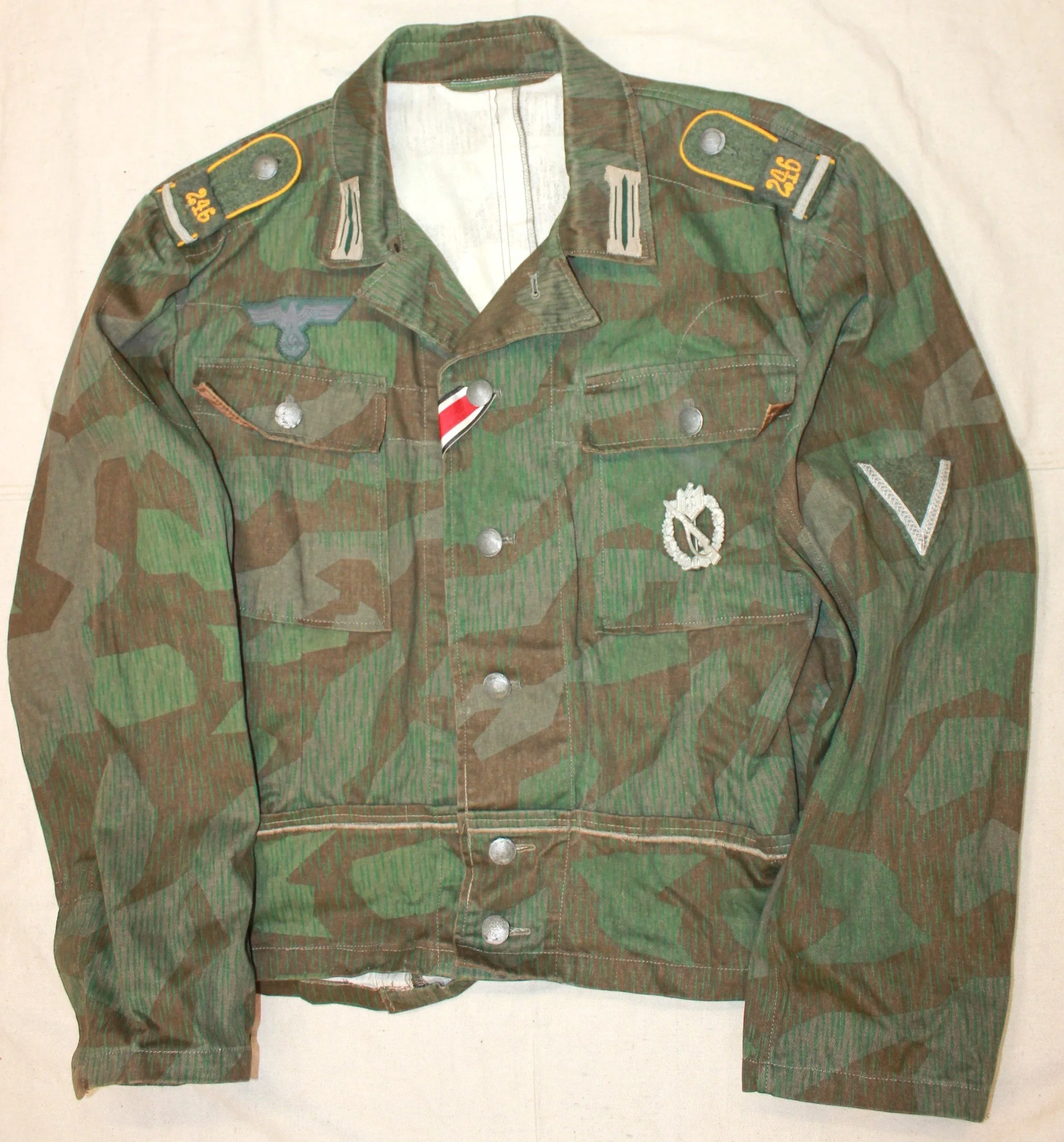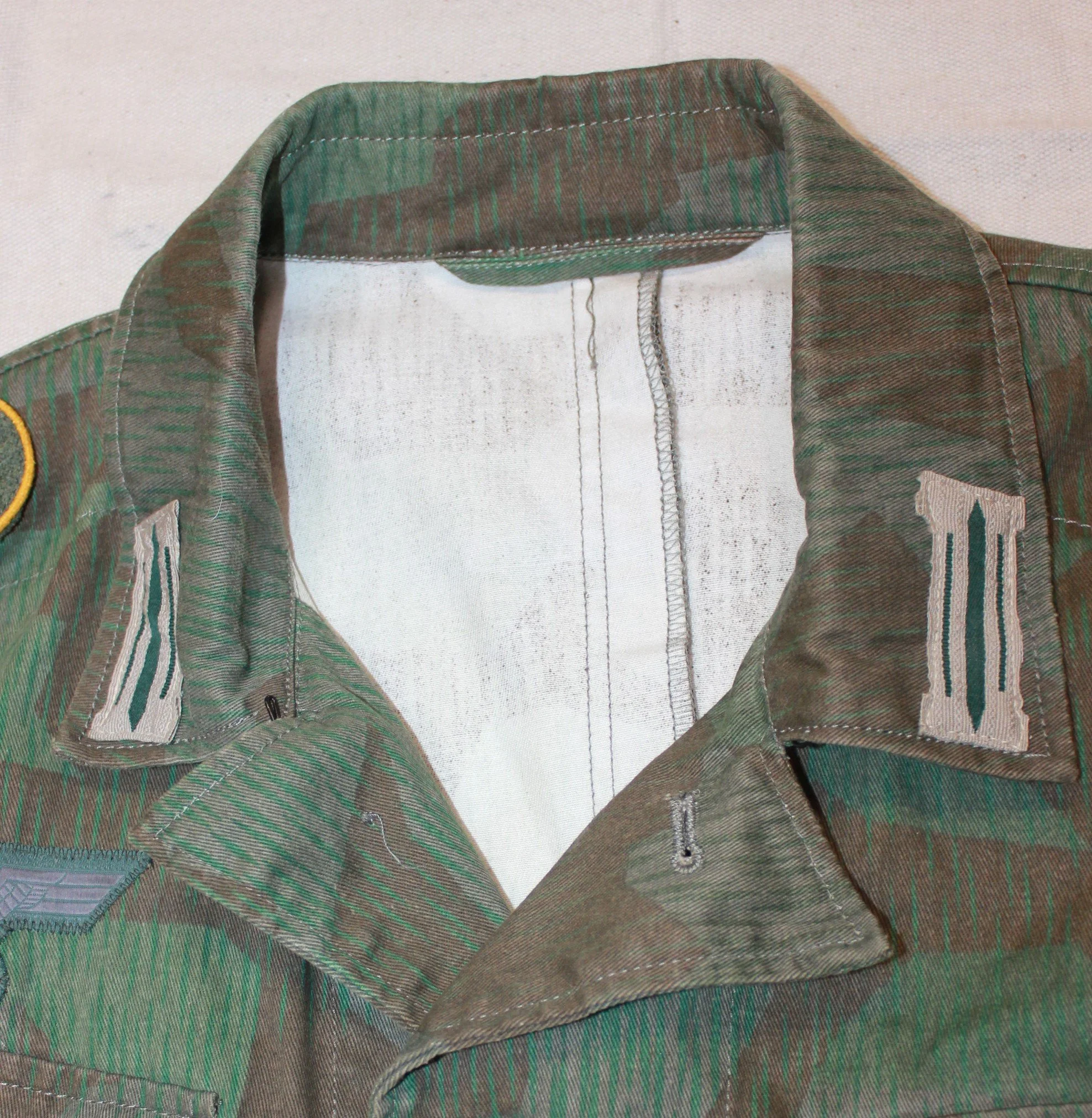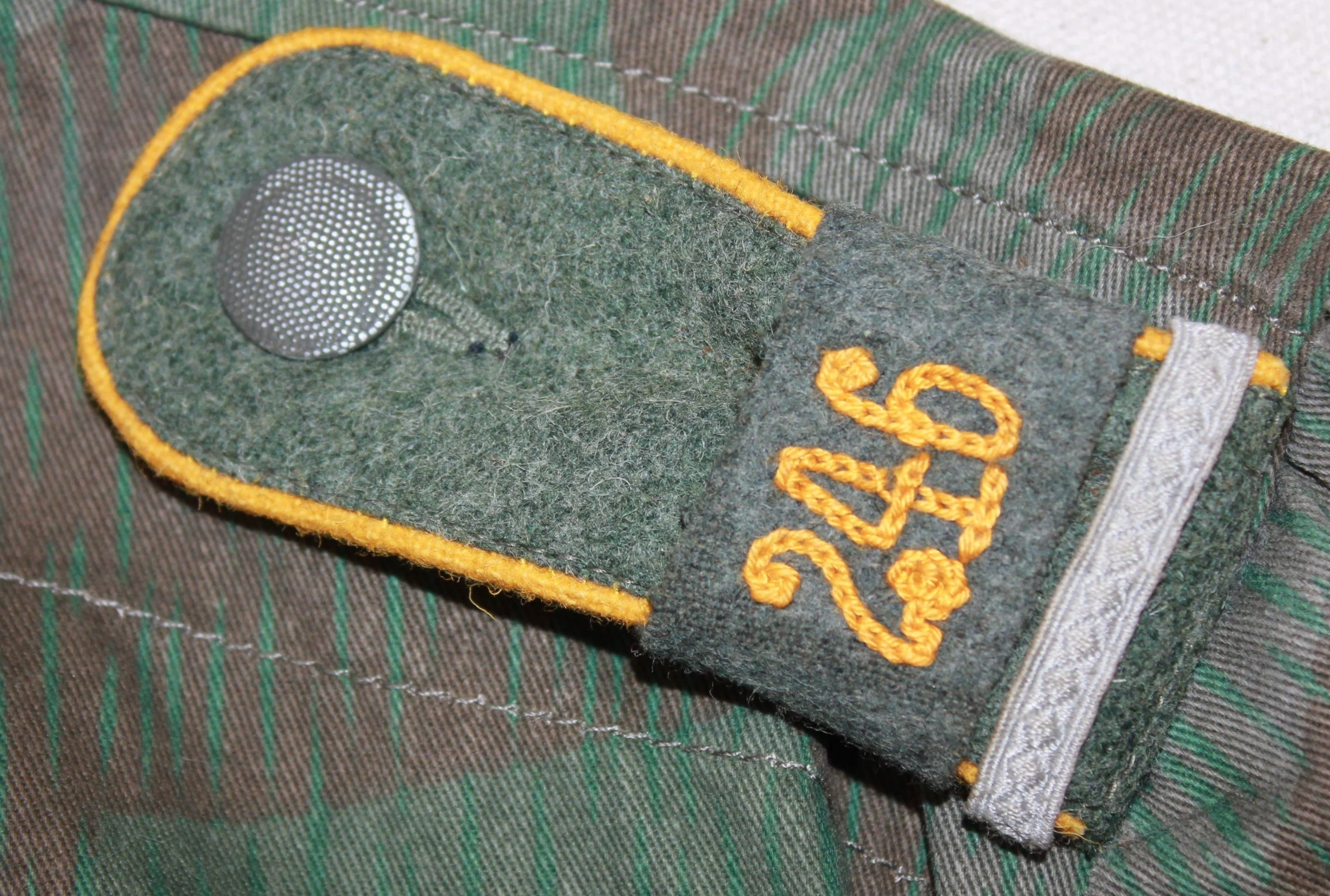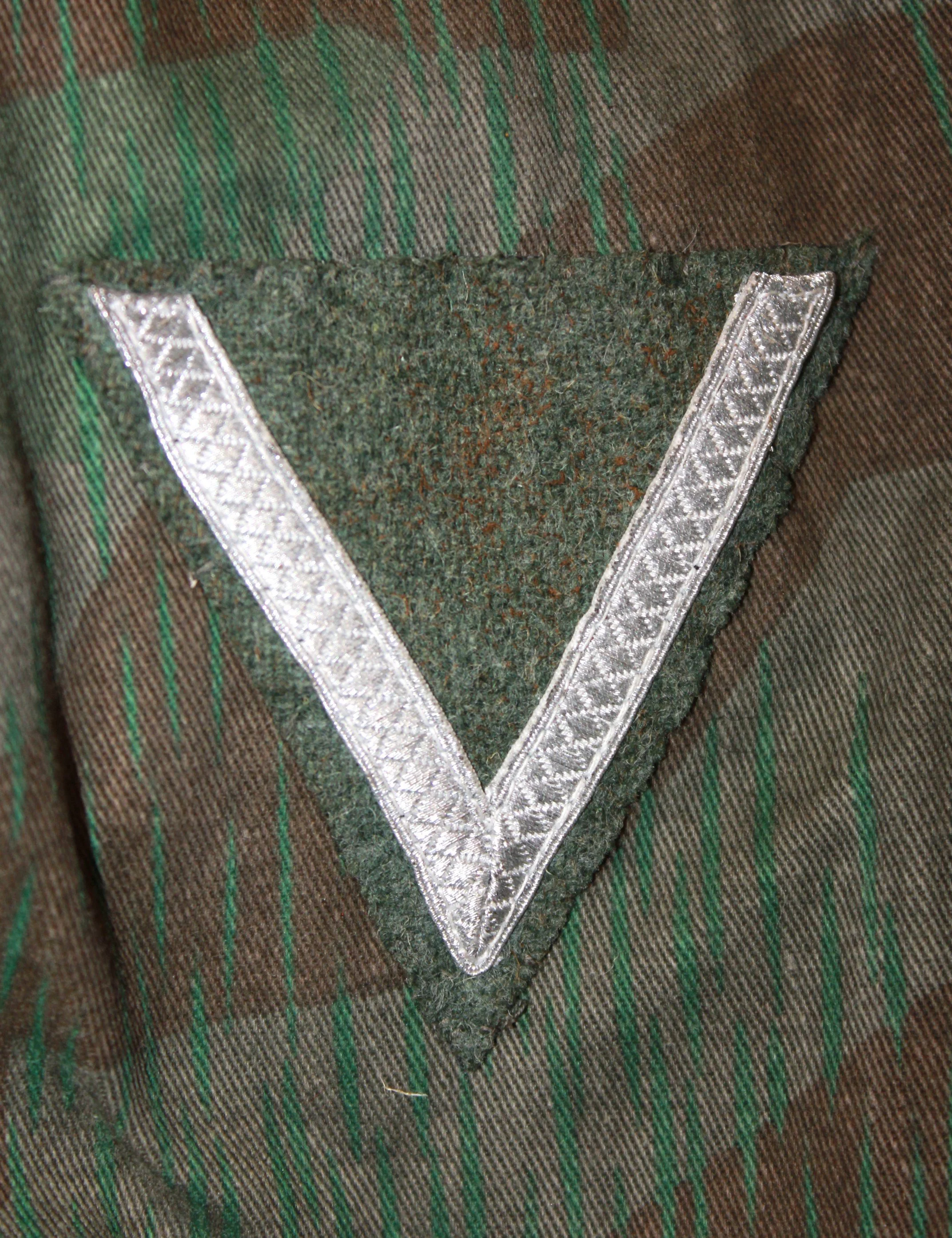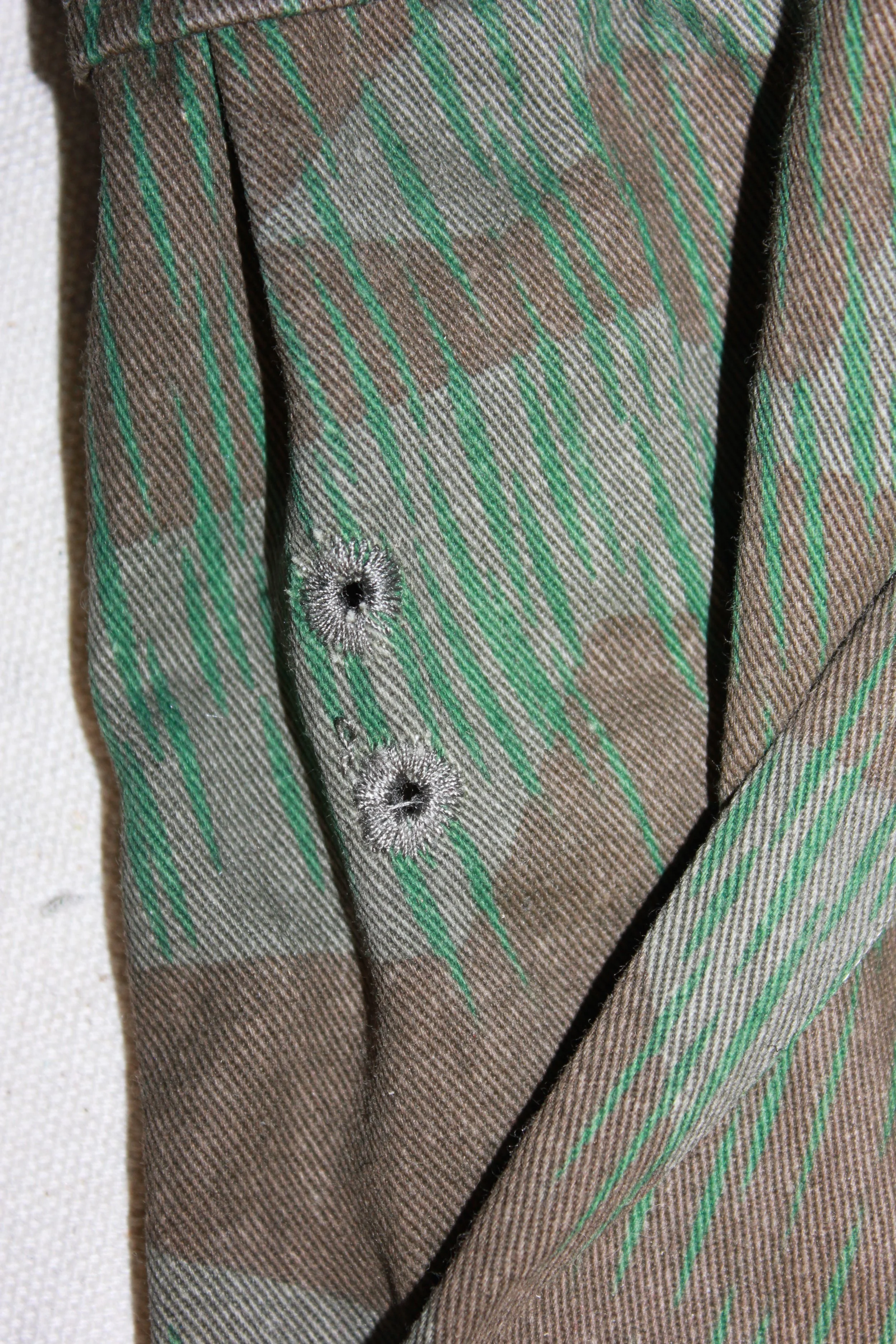Heer Aufklärungs ~ Abteilungen & Dragoon’s ‘Reconnaissance’:
Unteroffizier, 1. Kompany, Panzer Aufklärungsabteilung, 1940:
The Aufklärungs~Abtieilung was the eyes and ears of the Panzer Divisions in the Kompanies of the Panzer Divisions. The 1. and 2. Kompanie was equipped with light armor in the form of the Sd. Kfz. 231 and the four-wheel Sd. Kfz. 222/223 respectfully.
The Armored Car was able to quickly cover the terrain out in front of the Division, and stay ahead of them, searching out enemy positions, and strong points, and packed some firepower to suppress the enemy fire, then break contact, and make a quick retreat, back to their lines.
Crew Members wore the “Sonderbekleidung der Panzertruppen,” initiated in late 1934 for the men of the new Panzer formations. Influenced by the imperial German “Death’s Head” Hussar uniforms, these were black, double-breasted tunics with the Death’s Head emblem on them. The Death’s head was also used in the First World War, by the infant Panzer Corps, the “Rose” piped collar is indicative of the pre-war and very early war variation of the uniform.
The “A” cipher on the shoulder straps shows that the Unteroffizier is a member of the Aufklärungs-Abteilung. Interestingly, the NCO tress on the shoulder boards is from a later period, mismatched with the uniform’s period, and the Dark Green backing to them indicates they came from his feldgrau-feldbluse.
Attached to the right shoulder through the steps button, the incorrectly hung “Schützen-Abzeichen” (it should have its own button under the shoulder board strap) is a Marksman’s Lanyard, and officially not on battle uniforms, so, maybe he was on parade? or just post away with the uniform. The initial style, and used for all soldiers.
Black Trousers are also worn with the uniform; they feature their special design too, with an internal belt along the button-down flap pockets, and drawstring cuffs for wear with black, lace-up boots, and short Tanker boots. The standard gray shirt and black tie complete the uniform.
The “Eisernes Kreuz II. Klasse” ribbon is worn in the upper button-hole (This was given only for combat leadership). and he’s earned the “Panzerkampfabzeichen” could only be earned from being “In Combat”, so the uniform we’ll call it! It depicts a time soon after the war started in 1939, but possibly, before re-assignment, or re-deployed to the next objectives of 1940-41.
The M1934 Schutzmütze (Vehicle Cap), commonly called the “Panzer Beret”, was also issued to Armored Crewmen and seen in many period photographs. It consisted of a soft, padded crash helmet, which served to protect the heads of the crewmen as they were sometimes jolted and thrown around in the early tanks with “Stiff” suspension. Injuries could easily be sustained over rough ground. This was covered with an elaborate, large black beret that sort of concealed the helmet under it. The helmet was circular and manufactured with a 1.5 cm-thick red rubber sponge.
The exterior was covered with black cloth, the interior with black “oilcloth” with a leather sweatband. In addition, there was a 3.5 cm cloth-covered rubber sponge around the circumference of the helmet groove to hold the elastic band over the cover plate. There were 6 ventilation holes in a circular pattern and a hole in the center. The cover was an oversized black wool beret, with an elastic band on it to hold it fast to the helmet, and then the bottom of the helmet folded over the edge of the beret. The Beret had cloth insignia added to the front of it, similar to a peaked cap of the time.
By order HV 35, No. 646, dated 30 October 1935, a standard had been established for the wearing of insignia on the Black Panzer Beret. It consisted of the National Eagle but the Cockade. By order HM 41, No. 64, dated 15 January 1941, the Black Panzer Beret was abolished, and was, however, issued to the Pz.Kfw. 38(t), of Checz manufacturer, kept theirs, as well as drivers and co-drivers of early personnel carriers, and according to order HM41, No. 277, dated 7 March 1941, for drivers and co-drivers of armored tractors of the type Sd. Kfz. 251. Although out of production in 1941, it continued to be worn after that date, and is seen in photographs, but was pretty much phased out by the end of 1942.
Oberleutnant, Panzer-Aufklärung 3. ‘Dragoon’:
I don’t have this darn story anymore either, sorry, I’m still looking, but I can tell ya, I’ll bet it was built around the Crowned Eagle on his Cap, the traditional Dragoons emblem.
Ritterkreuzträger Major Gerlach von Gaudecker-Zuch, Aufklärungs-Abteilung 26:
The Schwedter or Dragoner Adler- Breaking Down the Wartime Organizational Changes originally worn by 1. Brandenburgisches Dragoner-Regiment. .2. It was then authorized for wear by the Regimental Staff & 2 Squadron of the 6. Reiter Regiment, expanding to 4. Squadron in 1926. In 1937, wear was authorized for Kradschützen Bataillon 3 of 2. Panzer-Division, along with all units of 3. Kavallerie-Division.
During the Afrika campaign, Aufklarungs-Abteilung (mot) 3 (A.A. (mot.3) and A.A. 33, formerly of the 3. Panzer Division became part of the newly formed 5. Leichte Division, later the 21. Panzer Division and then part of the 15th. Panzer Division. Additionally, three units with Kavallerie-Regiment 6 lineage: Schnelle Abteilung 512 (Divisions-Füsilier-Bataillon 719 as of August 1944), and Divisions-Füsilier-Bataillon 352 and 712 had personnel who wore the Dragoner-Adler commemorative tradition badge. All of these units drew upon Kavalleri -/Radfahr-/ Aufklaerungs-Ersatz-Abteilung 6 (designation changed during the war) for their replacements.
Gerlach von Gaudecker-Zuch:
Little is recorded about von Gaudecker-Zuch before the war. Having joined the Reichswehr after his high school diploma, he must have trained and then obtained officer status with the 6.Reiter Regiment. He took part in the Polish and French campaigns. At the beginning of the Russian campaign, he was Rittmeister with Aufklärungs-Abteilung 26, earning the Deutsches Kreuz in Gold in November of 1941. He was transferred to the 4. Panzer Division, where he took command of the II. Bataillon Panzergrenadier-Regiment 33 on 17 October 1943 was promoted to commander in November of the same year.
He was awarded the Ritterkreuz on 8 August 1944 as an Oberst while serving with the Abwehr during the retreat in Belarus and Poland. On 15 January 1945, he was transferred to the Führerreserve. In 1956, he joined the Bundeswehr as a colonel and worked in various staff positions. From 1959 to 1962, he led the Panzerbrigade 15. In 1962, he became commander of the VBK 41 in Koblenz, retiring in 1967.
A standard special uniform for Panzertruppen in Feldgrau worn by von Gaudecker-Zuch before his leaving Aufklarungs-Abteilung 26 after earning the German Cross in Gold as well as the Nahkmpfspange in Bronze and the Ehrenblattspange des Heeres was added to the E.K.II at a later date. Gaudecker-Zuch earned the Sturmabzeichen, Ost Front, and Eisernes Kreuz I. u. II. with A.A.26.
Unteroffizier, Kavalrie Reiter Regiment 6 (Dragoon), 4 Zug:
Major, Aufklärungs-Abteilung 2, (2-Part set!):
Many of my stories were stolen, and the site has been through several crashes; some stories have been lost, but eventually, one will get in here.
Feldwebel Stabs, Aufklärungs Abteilung 246, 246. Infanterie-Division, 1941, Honor Guard:
Infantrie Division 246 was established on August 26, 1939, in Wehrkreis XII and was transferred to border security between Karlsruhe and Brühl, on the Rhine. During the Battle of France, the division held its border position. Until June 15, when it took part in clearing the area of the Maginot Line between Oberseebach and Niederroeder. Following the Battle of France, the division remained on coastal defense until February 1941, when it was deployed to the Russian Front at Rzhev-Bjeloje, where it fought the rest of the war until destroyed in August 1944.
Abteilung 246 was composed of troops from Kavallerie Schwadrons, with both the Aufklärung Schwadrons having their horses replaced by bicycles. The Abteilung contained motorized Nachrichten and Panzerjäger-Zugs, horse-drawn Geschütz-Zug, and motorized Stabs.
The Fahnenträger Armellabzeichen or sleeve shield for standard-bearers, was introduced in 1936. This shield-shaped badge was woven on a bluish-dark green or black ground and had a size of 11.2 cm in height and 10.2 cm in width. It showed two crossed troop flags in the Waffenfarben of the branch represented, in this case, gold yellow. The shield was composed of a black and white Heeresadler with aluminum-colored oak foliage, five leaves, and two acorns.
The Feldwebel had earned the Reiterabzeichen in Silber during his prewar Kavallerie service. During the Battle of France, he was awarded the Eisernes Kreuz II. Klasse for combat leadership and the Verwundetenabzeichen in Schwartz. He wears these on an M40 Feldbluse, probably issued to replace the one he was wounded in, identified bythe lack of the dark-green collar and shoulder insignia with war period Adler and Litzen.
To enhance wartime security and to streamline uniform manufacturing, the Abteilung numerical cipher is made on a slip-on band of Feldgrau cloth that can be worn on other uniforms or removed for security. When not wearing the Stahlhelm, he wears either a Feldmütze or Schirmmütze with golden yellow piping. Originally assigned to the 1. Kompanaie / Kavallerie Schwadron 1 was then reassigned to the Stabs or headquarters element.
“new”Gefreiter u. Unteroffizier Anwarter 246 Aufklarungs-Abteilung 246:
Volksgrenadierdivision 246. Infanteriedivision was organized in Darmstadt as part of der dritte Welle or the 3rd wave of creation of active divisions of the rearmament program in August 1939. Following service on the West Wall between Karlsruhe and Brühl in 1940, it remained in reserve during the Battle of France. Returning to the garrison in Darmstadt from August 1940 to February 1941, it was then deployed for occupation duty in France until February 1942.
In Marz 1942 the division became part of Armee Gruppe Mitte defending Smolensk and Bely, taking part in anti-partisan actions in the Battle of Rzhev in Operation Seydlitz. In 1943, it withdrew to the rear positions near Dukhovshchina. In June 1944, it was trapped along with 53. Armeekorps in Vitebsk during Operation Bagration. The division suffered heavy losses, with many, including the command, surrendering to the Soviets. It was officially disbanded in August 1944. 246. Volksgrenadierdivision was formed from the Ost Front surviving veterans, Kriegsmarine u. Volksdeutsch in Prague.
They were quickly readied for action by their commander, Oberst Gerhard Wilck, and shipped to eastern France at the end of September 1944. In October 1944, they relieved 116. Panzerdivision at Aachen.
They became besieged and were engaged in heavy street fighting, and the division was finally forced to surrender the city, but surprisingly managed to extract a significant proportion of its men. To make up for its casualties from Aachen, it absorbed the remnants of the 49th. Being reviewed in the Schnee Eifel by Commander, Oberst Peter Körte.
Infanteriedivision. With a new commander, Oberst Peter Körte, the division prepared for the Ardennes offensive. However, during November, they became heavily involved in the battle for Hürtgenwald and were unable to extract themselves from the battle.
By the beginning of December, they had been worn down by a month of hard fighting and were withdrawn to once more receive a wave of reinforcement, this time untrained Luftwaffe ground crews. In January 1945, they were held in reserve for possibly a last-ditch attempt to take Bastogne but were never used.
Once the US Third Army broke through at Prüm, the division was forced onto the defense and conducted a fighting withdrawal through the Schnee Eifel region in March 1945, finally surrendering after Oberst Körte was killed south of the Mosel River.
Der Gefreiter wears a custom-made Model 1944 Getarntfeldjacken, probably acquired during the late summer refit to the Volksgrenadierdivision. Straining to fill leadership holes in the ranks, the command has selected him to go to the next available NCO academy or Unterführerschule, which is denoted by the single loop of tress below his numbered Abteilung Aufschiebenschlaufen on his Schulterklappen. With this, he wears an early war Feldmütze which retains the Goldgelb Sautasche of the Aufklarungstruppen.















